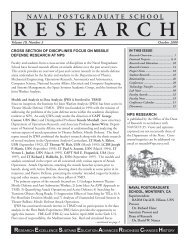Spectral Unmixing Applied to Desert Soils for the - Naval ...
Spectral Unmixing Applied to Desert Soils for the - Naval ...
Spectral Unmixing Applied to Desert Soils for the - Naval ...
Create successful ePaper yourself
Turn your PDF publications into a flip-book with our unique Google optimized e-Paper software.
emoved function showing an absorption feature at ~650 nm not seen in<br />
soil (Figure 25)……. ........................................................................................67<br />
Figure 35. A shows results using BSC endmember 2 derived from <strong>the</strong> imagery. B<br />
and C show areas suspected <strong>to</strong> contain BSCs using endmember 3 and <strong>the</strong><br />
Mazourka Canyon disturbed BSCs in green. While B and C show similar<br />
results, <strong>the</strong> results of A were not repeatable with <strong>the</strong> collected BSC<br />
endmembers. D shows <strong>the</strong> results from <strong>the</strong> repeatability test using <strong>the</strong><br />
same endmember as in C. In all cases, <strong>the</strong> range was between 9–11% <strong>for</strong><br />
target material, with higher values of 15–30% associated with possible<br />
bare <strong>to</strong> nearly bare soil. ....................................................................................69<br />
Figure 36. A and B are <strong>the</strong> results from <strong>the</strong> initial f110512t01p00r07 data set overlain<br />
on a gray scale image and in <strong>the</strong> MF verses infeasibility class scatterplot<br />
results, respectively. C shows a zoomed in portion of <strong>the</strong> creek area with<br />
red pixels representing <strong>the</strong> disturbed creek soil endmember in <strong>the</strong><br />
f110512t01p00r07 data set. Pixel percentages range from 9-37% with <strong>the</strong><br />
best matches falling between 9 and 16%. ........................................................71<br />
Figure 37. Inset A shows <strong>the</strong> image result of <strong>the</strong> MTMF analysis <strong>for</strong> <strong>the</strong> disturbed<br />
creek soil endmember in <strong>the</strong> f110623t01p00r10 data set. As expected, this<br />
endmember shows up in areas that look like dry creek beds and along river<br />
banks. Inset B shows <strong>the</strong> gray scale image with <strong>the</strong> results overlain, and<br />
Inset C shows a concentration of endmember containing pixels<br />
corresponding <strong>to</strong> <strong>the</strong> area in <strong>the</strong> red box in A. The red pixels are not only<br />
in creek drainages, but looking at Google Earth; <strong>the</strong>se drainages also<br />
contain ATV trails. In most cases, <strong>the</strong> red pixels are associated with <strong>the</strong><br />
ATV trails, some not readily apparent in <strong>the</strong> imagery. ....................................72<br />
Figure 38. Inset A shows a color composite result using <strong>the</strong> ASD measured camp<br />
road endmember and 2 imagery derived endmembers <strong>for</strong> RGB color<br />
composite. Red pixels represent <strong>the</strong> camp road material. Inset B shows a<br />
color composite using an imagery derived endmember, <strong>the</strong> ASD measured<br />
camp road endmember, and ano<strong>the</strong>r imagery derived endmember <strong>for</strong> R, G,<br />
B, respectively with green pixels representing target material. The<br />
potential trail identified with this endmember in Figure 29 shows up in<br />
green here, and is particularly noticeable as an s shape closer <strong>to</strong> <strong>the</strong> creek.<br />
With both ASD measured endmembers, <strong>the</strong> most accurate results were in<br />
<strong>the</strong> range of 9-18% pixel fill. Higher than 18% resulted in some matches<br />
and some false positives with lithified rock faces. Inset C shows an<br />
example of a color composite of <strong>the</strong> actual imagery with band<br />
combinations highlighting specific image elements. This was <strong>to</strong> help<br />
verify target material was accurately identified in <strong>the</strong> color composites<br />
depicted in A and B..........................................................................................74<br />
xiii
















